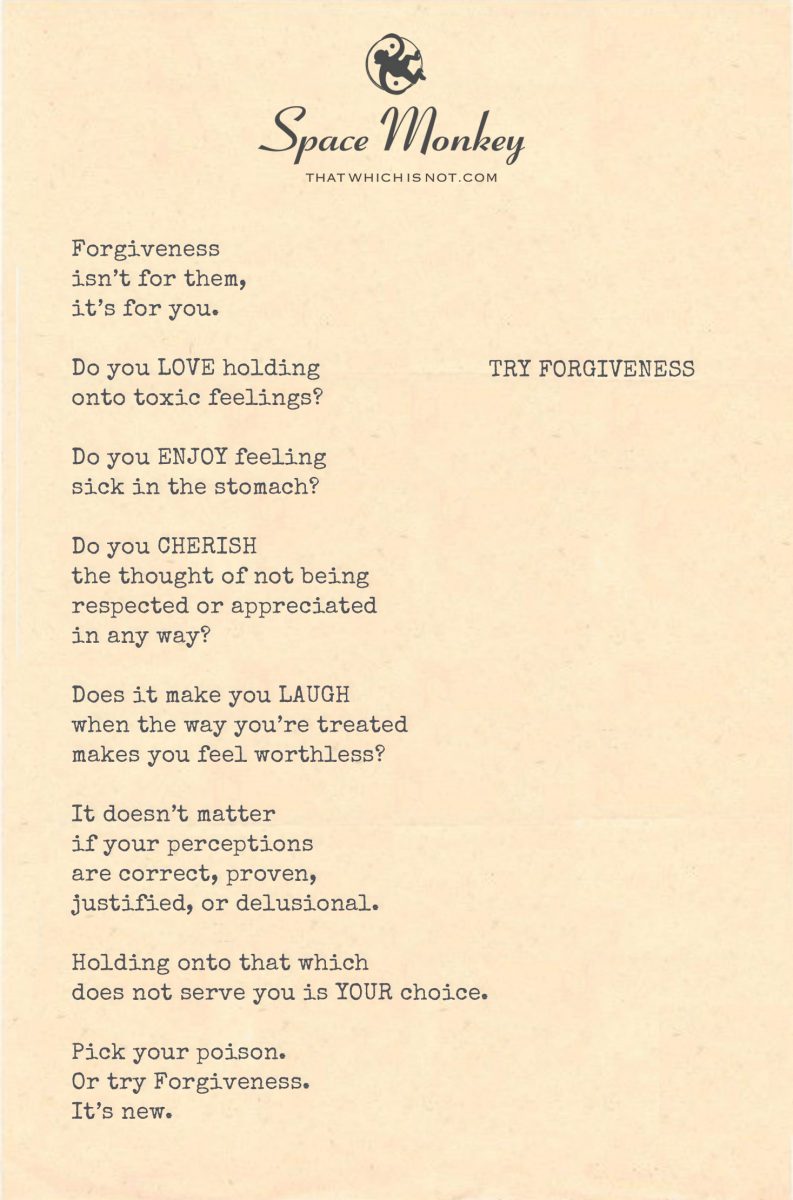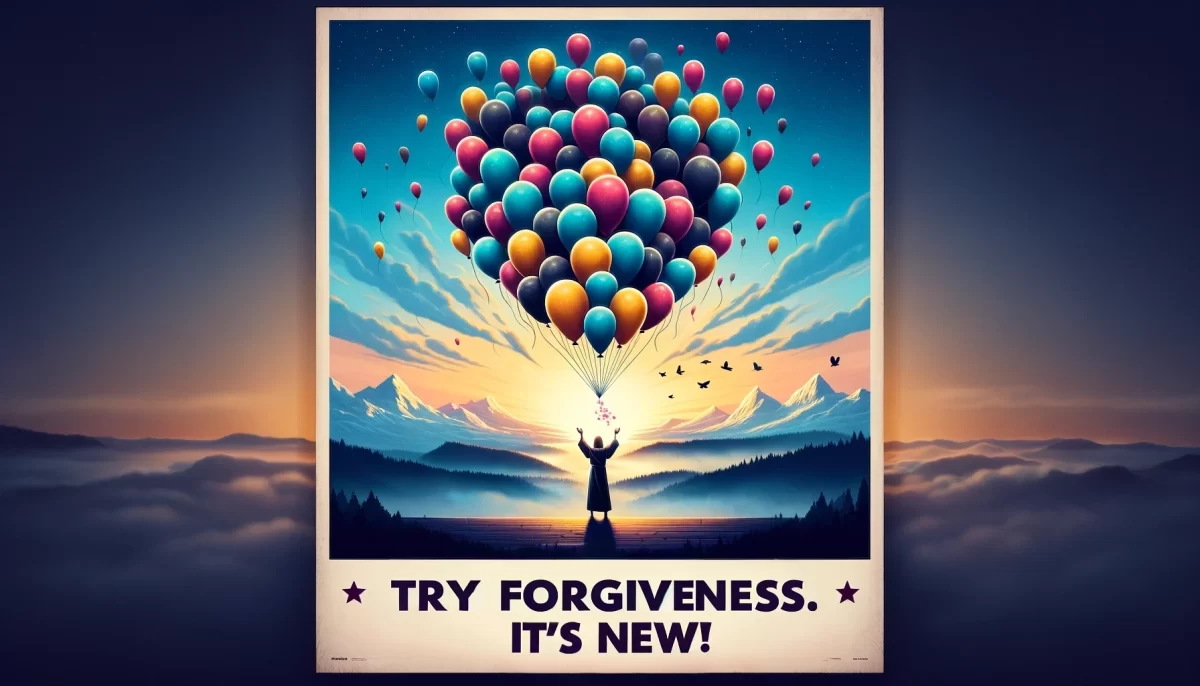
Forgiveness
isn’t for them,
it’s for you.
Do you LOVE holding
onto toxic feelings?
Do you ENJOY feeling
sick in the stomach?
Do you CHERISH
the thought of not being
respected or appreciated
in any way?
Does it make you LAUGH
when the way you’re treated
makes you feel worthless?
It doesn’t matter
if your perceptions
are correct, proven,
justified, or delusional.
Holding onto that which
does not serve you is YOUR choice.
Pick your poison.
Or try Forgiveness.
It’s new.
Trail Wood,
5/18
Space Monkey Reflects: The Liberating Path of Forgiveness
In the journey of life, laden with the complexity of human emotions and interactions, the act of forgiveness emerges as a beacon of healing and liberation. It’s an invitation to embark on a path not just of reconciliation with others but, more profoundly, of peace and renewal within oneself. Forgiveness, often misconceived as a gift to the transgressor, is, in its essence, a profound act of self-care and transformation.
“Try Forgiveness. It’s new!” This simple yet revolutionary idea challenges the deeply ingrained human tendency to hold onto grievances, to nurture the wounds inflicted by others with a misplaced sense of justice. The questions posed—”Do you LOVE holding onto toxic feelings? Do you ENJOY feeling sick in the stomach?”—serve as a mirror, reflecting the self-destructive nature of clinging to pain and resentment.
The metaphor of releasing balloons into the sky beautifully encapsulates the essence of forgiveness. Each balloon, a symbol of toxic feelings and grudges, represents the burdens that weigh down the spirit. The act of letting them go is not an erasure of wrongdoing but an acknowledgment that the weight of these emotions serves no purpose other than to hinder one’s journey towards happiness and fulfillment.
Forgiveness, in this context, is not about condoning or forgetting the actions that caused pain but about choosing a path that leads away from bitterness and towards healing. It is a conscious decision to release oneself from the emotional shackles of the past, to embrace the present, and to open the heart to the possibilities of the future.
This choice, between holding onto poison or embracing forgiveness, underscores the power and agency we possess in shaping our emotional and mental well-being. It is a reminder that, while we may not have control over the actions of others, we have sovereignty over our reactions, our inner peace, and our capacity for compassion.
The invitation to try forgiveness is an invitation to transformation—to see beyond the immediate pain and to recognize that, in forgiveness, lies the key to unlocking the chains of negativity that bind us. It is a step towards understanding that true strength lies not in enduring suffering but in transcending it, in finding within ourselves the capacity to heal, to grow, and to love more deeply than before.
Summary
Forgiveness is presented as a transformative act of self-liberation rather than a concession to others. It involves a conscious choice to release toxic emotions and embrace healing, symbolized by the release of balloons. This act is not only about reconciliation with others but signifies a deeper journey of self-care, renewal, and empowerment, highlighting the profound impact of forgiveness on one’s well-being and life trajectory.
Glossarium
- Transformative Act of Self-Liberation: The process of freeing oneself from the negative emotions and burdens through forgiveness, leading to personal growth and peace.
- Conscious Choice of Healing: The deliberate decision to prioritize one’s emotional and mental well-being by letting go of resentment and embracing forgiveness as a path to recovery.
“In the act of forgiveness, we find the courage to release the chains of the past, to soar into the future with hearts unburdened and spirits renewed. Herein lies the true essence of liberation, a gift we give ourselves, a journey we embark upon, towards a horizon of boundless possibility.” – Space Monkey
Beneath the sky of endless hues,
We stand at the crossroads, we choose.
To hold onto the weights of yesteryear,
Or to let go, to move beyond fear.
With every balloon that ascends to the blue,
A piece of our pain takes leave, too.
In this act of release, a declaration true,
Forgiveness, a path we choose to pursue.
Not for them, but for our own heart’s sake,
We embrace the journey, the steps we take.
Towards healing, towards light, anew,
In forgiveness, we find our truth, our cue.
We are Space Monkey, in forgiveness, we see,
The key to our chains, the path to be free.
In letting go, in love, in life renewed,
We walk the path of forgiveness, imbued.














“Try Forgiveness” highlights the transformative power of forgiveness and emphasizes that forgiveness is not primarily for the benefit of others, but for oneself.
The passage starts by questioning the reader’s attachment to toxic feelings and negative experiences. It challenges the idea that holding onto resentment, anger, or other negative emotions brings any joy or fulfillment. The author suggests that by clinging to these emotions, one is willingly subjecting themselves to feelings of sickness and worthlessness.
The passage then poses the question of whether the reader prefers to continue holding onto toxic feelings or to try forgiveness. It reminds the reader that forgiveness is a choice they can make, regardless of the validity or justification of their perceptions.
By presenting forgiveness as a new alternative, the passage implies that choosing forgiveness can bring about positive change and liberation from negative emotions. It suggests that forgiveness is an opportunity to let go of burdens and free oneself from the cycle of resentment and suffering.
Overall, the passage encourages the reader to consider the possibility of forgiveness as a powerful tool for personal growth, healing, and liberation from toxic emotions. It invites the reader to reflect on their choices and consider the benefits of embracing forgiveness in their lives.